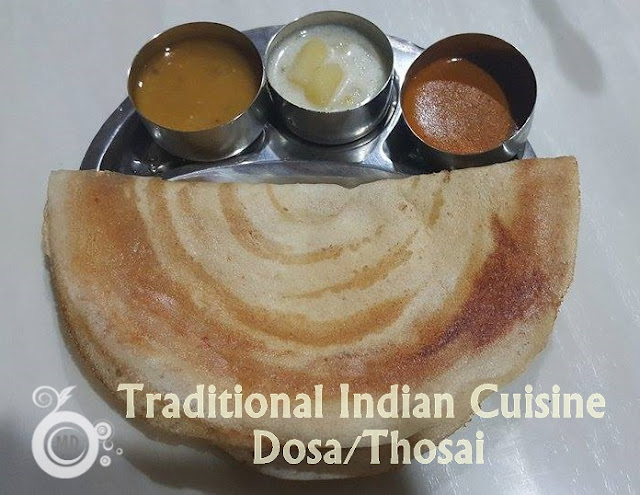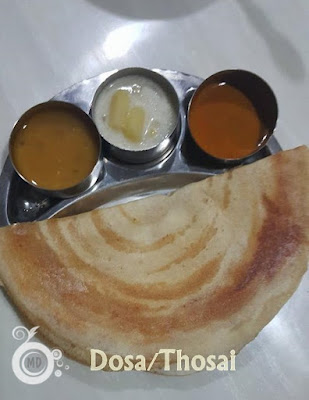Dosa is a type of pancake from the Indian subcontinent, made from a fermented batter. It is somewhat similar to a crepe in appearance. Its main ingredients are rice and black gram. Dosa is a typical part of the South Indian diet and popular all over the Indian subcontinent. Traditionally, Dosa is served hot along with sambar, stuffing of potatoes and chutney. It can be consumed with idli podi as well. It can be served with chicken and fish curry also. Dosa is high in carbohydrates and contains no added sugars or saturated fats. As its key ingredients are rice and black gram, it is also a good source of protein.
There are many variations when making dosa, especially in the amount of using raw rice and urad dal.
This is a family recipe, which gives a soft dosa and remains soft even after many hours. I used a combination of normal rice with parboiled rice as it will lessen the fat or starch when consuming dosas and healthier as well.
The standard proportion or ratio of rice and urad dal is for every 2 cups of rice, 1 cup of urad dal (2:1). I have used rice cooker cup and provided it in gm. You can measure using any type of cups or even mugs, however, ensure in using the same cup when measuring rice and urad dal. Raw rice I have taken a handful.
125gm parboiled rice (Indian rice/puzhungal ari)
125gm raw rice (normal jasmine or basmati variety/ pacha ari)
140gm urad dal (whole)
100gm cooked raw rice (overnight refrigerated rice would be good)
1/2 tbsp fenugreek seeds
1 tsp salt
You need to soak the ingredients a day ahead. If you want to prepare dosa for morning breakfast, then soak the ingredients a day earlier in the morning. If you are preparing for dinner, then you can soak the ingredients a day ahead at night. I am giving the steps to prepare for dinner.
At night, wash both raw rice and parboiled rice nicely until water runs clear. Then soak both rice in a bowl with water filled about half above the rice level. Wash the urad dal nicely until water runs clear as well, mix in fenugreek seeds. Add more water to urad dal, as it will double in volume overnight. Soak both rice and urad dal separately and leave it overnight.
The next morning, first ground the rice finely in a mixer. Add only enough water for grinding.Ensure the paste is smooth. Transfer to an aluminum pan/bowl/pot. Next, drain the water from urad dal mixture, mix in cooked rice. Then grain the urad dal into a fine paste as well. Pour the mixture into the rice mixture. Add in salt and stir well to combine both the rice and urad dal batter. Use a ladle to mix or you can use your hand also. Sometimes using ladle will not encourage the batter to double in volume, therefore some use their hand to mix well. Leave the mixture to ferment for at least 8 to 9 hours. If you have grind the ingredients at 8am, then by 6 pm you can start preparing the dosa.
The batter should be double in volume, this shows that the fermentation of the batter was successful. Slowly stir the batter until the volume reduces to its original. Take a few ladleful of needed batter. The rest, transfer to an airtight container and keep refrigerated for later use. The batter can last up to 5 days. In the batter that you have taken, add about one to two tablespoons of water, if too thick, add a bit more ( the consistency can vary depending on how much water you used for grinding. Therefore make sure that the batter is not too watery. (Check the clip for better understanding)
For preparing plain dosa:
Heat a non-stick dosa pan (advisable to use a nonstick pan for the novice) grease lightly with oil, pour a ladleful of batter in the center of the pan, and shape it in a circular motion (check out the clip below) or swirl around in a circular motion. Add a bit of oil around the edges of the dosa, and the center of the dosa as well, this will ensure the dosa becoming crisp and easier to lift from the pan. Once it turns brown and crisp you can slowly turn and cook the other side, just leave for a few seconds.Then turn it back, fold into half and transfer to a serving dish. Do the same until the batter finishes. Stir the batter each time before using. Grease the pan occasionally to avoid it sticking.
If using a cast iron pan, grease with oil, before pouring.
Note: If the pan is too hot, the batter will stick on it, therefore sprinkle some water to reduce the heat of the pan, before making the next dosa. If you prefer not to use oil around the edges, then you need to leave the dosa to cook much longer, slowly try to lift the edges, you need to wait until you can easily lift the dosa and turn it to cook the other side.
Serve dosas with chicken ,fish curry, sambar , or ishtoo (Kerala potato stew). I love to eat dosas with ishtoo. Or you can serve with coconut chutney or onion chutney.
Note:
1) With the same dosa batter , you can prepare masala dosa, planta dosa etc. Recipes will be shared soon!
2) If a person is used to raw rice (Pachaari) or parboiled rice (Puzhungalari), it is difficult to change their digestive system. Therefore use with discretion. In terms of nutrition, parboiled rice has more nutrition due to the tiny amount of protein, fatty acids, vitamins and minerals in the bran is transferred to the rice in the parboiling (steaming) process.
3) You can replace the cooked rice with beaten rice, however, the texture wouldn't be as light and thin as using cooked rice. Personally, I prefer to use cooked rice when making both dosa and idli.
4) You can use either jasmine/basmati rice or parboiled rice for the cooked rice. Both give thin and light dosas.
Recipe link to:
Coconut Chutney
Chicken Curry
Fish Curry
Sambar
Ishtoo
Any problem, pm me through facebook, and I will guide you!! Thank you for taking the time to visit my blog. Do try and leave your comment.
Facebook: https://www.facebook.com/malaysiandelicacy/
Kindly 'like' the page.
https://www.instagram.com/malaysiandelica
https://www.twitter.com/malaysiandelicacies
https://www.pinterest.com/malaysiand/
https://plus.google.com/+SuN
There are many variations when making dosa, especially in the amount of using raw rice and urad dal.
This is a family recipe, which gives a soft dosa and remains soft even after many hours. I used a combination of normal rice with parboiled rice as it will lessen the fat or starch when consuming dosas and healthier as well.
The standard proportion or ratio of rice and urad dal is for every 2 cups of rice, 1 cup of urad dal (2:1). I have used rice cooker cup and provided it in gm. You can measure using any type of cups or even mugs, however, ensure in using the same cup when measuring rice and urad dal. Raw rice I have taken a handful.
125gm raw rice (normal jasmine or basmati variety/ pacha ari)
140gm urad dal (whole)
100gm cooked raw rice (overnight refrigerated rice would be good)
1/2 tbsp fenugreek seeds
1 tsp salt
You need to soak the ingredients a day ahead. If you want to prepare dosa for morning breakfast, then soak the ingredients a day earlier in the morning. If you are preparing for dinner, then you can soak the ingredients a day ahead at night. I am giving the steps to prepare for dinner.
At night, wash both raw rice and parboiled rice nicely until water runs clear. Then soak both rice in a bowl with water filled about half above the rice level. Wash the urad dal nicely until water runs clear as well, mix in fenugreek seeds. Add more water to urad dal, as it will double in volume overnight. Soak both rice and urad dal separately and leave it overnight.
The next morning, first ground the rice finely in a mixer. Add only enough water for grinding.Ensure the paste is smooth. Transfer to an aluminum pan/bowl/pot. Next, drain the water from urad dal mixture, mix in cooked rice. Then grain the urad dal into a fine paste as well. Pour the mixture into the rice mixture. Add in salt and stir well to combine both the rice and urad dal batter. Use a ladle to mix or you can use your hand also. Sometimes using ladle will not encourage the batter to double in volume, therefore some use their hand to mix well. Leave the mixture to ferment for at least 8 to 9 hours. If you have grind the ingredients at 8am, then by 6 pm you can start preparing the dosa.
The batter should be double in volume, this shows that the fermentation of the batter was successful. Slowly stir the batter until the volume reduces to its original. Take a few ladleful of needed batter. The rest, transfer to an airtight container and keep refrigerated for later use. The batter can last up to 5 days. In the batter that you have taken, add about one to two tablespoons of water, if too thick, add a bit more ( the consistency can vary depending on how much water you used for grinding. Therefore make sure that the batter is not too watery. (Check the clip for better understanding)
For preparing plain dosa:
Heat a non-stick dosa pan (advisable to use a nonstick pan for the novice) grease lightly with oil, pour a ladleful of batter in the center of the pan, and shape it in a circular motion (check out the clip below) or swirl around in a circular motion. Add a bit of oil around the edges of the dosa, and the center of the dosa as well, this will ensure the dosa becoming crisp and easier to lift from the pan. Once it turns brown and crisp you can slowly turn and cook the other side, just leave for a few seconds.Then turn it back, fold into half and transfer to a serving dish. Do the same until the batter finishes. Stir the batter each time before using. Grease the pan occasionally to avoid it sticking.
If using a cast iron pan, grease with oil, before pouring.
Note: If the pan is too hot, the batter will stick on it, therefore sprinkle some water to reduce the heat of the pan, before making the next dosa. If you prefer not to use oil around the edges, then you need to leave the dosa to cook much longer, slowly try to lift the edges, you need to wait until you can easily lift the dosa and turn it to cook the other side.
Serve dosas with chicken ,fish curry, sambar , or ishtoo (Kerala potato stew). I love to eat dosas with ishtoo. Or you can serve with coconut chutney or onion chutney.
Note:
1) With the same dosa batter , you can prepare masala dosa, planta dosa etc. Recipes will be shared soon!
2) If a person is used to raw rice (Pachaari) or parboiled rice (Puzhungalari), it is difficult to change their digestive system. Therefore use with discretion. In terms of nutrition, parboiled rice has more nutrition due to the tiny amount of protein, fatty acids, vitamins and minerals in the bran is transferred to the rice in the parboiling (steaming) process.
3) You can replace the cooked rice with beaten rice, however, the texture wouldn't be as light and thin as using cooked rice. Personally, I prefer to use cooked rice when making both dosa and idli.
4) You can use either jasmine/basmati rice or parboiled rice for the cooked rice. Both give thin and light dosas.
Recipe link to:
Coconut Chutney
Chicken Curry
Fish Curry
Sambar
Ishtoo
Any problem, pm me through facebook, and I will guide you!! Thank you for taking the time to visit my blog. Do try and leave your comment.
Facebook: https://www.facebook.com/malaysiandelicacy/
Kindly 'like' the page.
https://www.instagram.com/malaysiandelica
https://www.twitter.com/malaysiandelicacies
https://www.pinterest.com/malaysiand/
https://plus.google.com/+SuN





Comments
Post a Comment